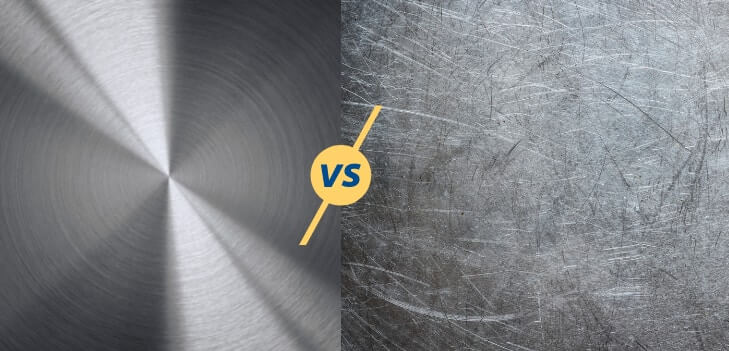One of the most common questions we receive from our customers, from novice to experienced, is what exactly is the difference between mild steel and stainless steel? Sure, aesthetically you can see the stark difference between the two materials, but a look under the surface will explain a lot more.
Today we’ll be looking at the properties that make each material unique: strength, ductility, hardness, aesthetics, and cost. But first, let’s discover the key differences between mild steel and stainless steel.
What is mild steel?
Before we compare the differences between mild steel and stainless steel, let’s discover what we class as mild steel. Mild steel is a type of carbon steel that has a low amount of carbon present within it. It is sometimes called low carbon steel, with roughly 0.05% to 0.25% carbon content.
This type of steel is not an alloy steel, so you won’t find many other elements present in its composition either. The great thing about mild steel is that it’s very ductile, but this does mean it can be a challenge to harden the steel.
You’ll find that it’s used in a variety of projects, thanks to the many benefits it offers. Common applications of mild steel include:
- Signs
- Structural steel
- Furniture
- Cars
- Fencing
What is stainless steel?
Stainless steel is a type of steel that’s very resistant to both rusting and corrosion. In order to be classed as stainless steel, the steel must contain less than 1.2% carbon and a minimum of 10.5% chromium. Some types of stainless steel add other elements, including titanium and nickel, which help to enhance its properties.
As stainless steel is resistant to corrosion, it’s the ideal type of steel to help transport chemicals, food, and liquids. It’s also a very low maintenance type of metal, so it’s easy to clean and preserve. Many household appliances are made out of this type of steel today, thanks to the many benefits it offers homeowners.
The Difference Between Mild Steel and Stainless Steel
Strength
Stainless steel does not offer much in the way of altering due to its inability to be as malleable as mild steel. This is attributed to stainless steel being a much harder material, which is often better suited to certain construction projects. That said, stainless steel is far more resistant to corrosion than mild steel due to its surface coating. It’s also very heat resistant, which is why it’s a good option for carrying chemicals and for household appliances.
Corrosion
One of the top benefits of stainless steel is that it is resistant to corrosion. This is why it’s often used to transport chemicals, liquids, and food, which may otherwise damage mild steel or other types of steel.
Hardness
When you look at both materials at a molecular level, the difference is simple. The key difference is that stainless steel is created from very little carbon and is instead alloyed with nickel, chromium, and other elements that provide its chemical properties. This in turn makes stainless steel very resistant to impact as the chromium alloy protects the material.
Mild steel itself is mainly composed of carbon, allowing itself to be reinforced with additional carbon or to be galvanized with zinc. Without the galvanization process, mild steel itself is very malleable and susceptible to damage. This is why it’s used in projects that require more precision, as it can easily be molded to fit your needs.
Aesthetics
One of the easiest ways to tell if a metal is stainless steel is to simply look at its surface. Famous for its smooth and polished surface, stainless steel differs from carbon steel by the amount of chromium present. Carbon steel rusts when exposed to air and moisture. This iron oxide film is active and accelerates corrosion by forming more iron oxide. Stainless steels have enough chromium present so that a passive film of chromium oxide forms which prevents further corrosion.
Cost
While the price of steel changes daily, some things remain constant: stainless steel will always be more expensive than mild steel. This is due to a bevy of factors such as supply, demand, and energy prices. Depending on your scope of work, if you can go without stainless steel, it’ll be better for your wallet. However, stainless steel’s durability and inviting look allow it to be a material that a majority of people overlook the costs to have their desired finish.
Which is Better: Mild Steel or Stainless Steel?
Now that you know what makes stainless steel and mild steel different, is one better than the other? The short answer is no. It all depends on your upcoming project and what you need to accomplish. If the surface of your next project is of the utmost importance, stainless steel is your best bet. However, if you need a large volume for structural purposes and the material will not be visible, mild steel will be the most cost-effective option.
Whichever one you choose, you’ll have an excellent material as the base for any project, offering you many advantages over other steel products. Happy building!
Visit Tampa Steel & Supply for Stainless and Mild Steel
Are you in need of steel supplies? Look no further than the professionals at Tampa Steel and Supply. We stock an extensive list of steel products for whatever project you need to tackle. We’re proud to have served our customers for nearly four decades and are ready to assist you with your steel needs. Have questions? Give us a call today to learn more, or stop by our beautiful Tampa showroom.
Request a Quote Online
Or Call Tampa Steel & Supply at (813) 241-2801

